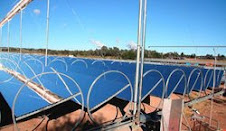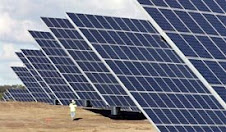Note from Yuya: Ontario seems to be finally abandoning the communistic energy policies, now if we could just get rid of the anachronistic plans for more heavily centralized and ludicrously subsidized nuclear power plants, we will have this province on the road back to world-class competitivness.
Ontario to pay premium for solar power; Wind, biomass also get break
TYLER HAMILTON, TECHNOLOGY REPORTER, theStar.com
Vern Sherwood's business just got a major energy boost and he didn't have to lift a finger.
The president and founder of Excess Energy Inc., a Mississauga-based supplier and installer of solar power systems, was overjoyed yesterday after the Ontario government confirmed it will pay 42 cents for every kilowatt-hour of electricity that comes from small solar electricity systems.
The generous rate — a seven- to eight-fold increase over what we see on our hydro bills today — is expected to make high-cost solar projects more appealing to early adopters of the technology, who can now earn back more of their investment by selling clean power to the province at a premium.
"This is totally wonderful news," Sherwood said. "We want to build this into a bigger company, and this means more work for us."
The premium rate for solar is part of the government's so-called standard offer program, a European-style approach to boosting small-scale deployment of renewable energy projects.
The province's interest in such a program was first reported in the Toronto Star last August, when former Energy Minister Dwight Duncan instructed the Ontario Power Authority to establish special pricing.
In addition to paying 42 cents per kilowatt-hour for solar electricity, the province announced it will pay 11 cents for clean electricity that comes from wind, biomass and small hydro systems that don't exceed 10 megawatts in size.
The program, which offers simple 20-year contracts and is expected to begin in June, is open to any business, organization, co-op and homeowner that can connect their project to the grid. Any system built after Jan.1, 2000, qualifies, meaning found money for those who have already invested the capital. "That's sure made a lot of my past customers happy," said Sherwood.
The government hopes the program will attract 1,000 megawatts of clean power over 10 years, or enough to supply electricity to 250,000 homes. But renewable energy experts say the potential is significantly higher if Ontario can gather the same momentum as Germany and Denmark, where similar programs have led to massive investment and created thousands of jobs in the solar and wind industries.
"It's historic for Canada. This is the most progressive renewable energy policy in North America," said Paul Gipe, a U.S.-based wind expert who, as acting executive director of the Ontario Sustainable Energy Association, played a pivotal role in nudging the province forward.
Well-known environmentalist David Suzuki, who joined Premier Dalton McGuinty in making the announcement, praised the province for setting an example for the rest of North America, even leaping ahead of progressive jurisdictions such as California.
"It puts Ontario at the absolute forefront of North America," said Suzuki, speaking from the manufacturing floor of Cambridge-based solar module maker Photowatt Technologies Inc.
"I think (Ontario is) going to force the rest of this continent to follow."
McGuinty said the simplicity of the program makes it possible for anyone to participate. He gave the example of farmers who could use vast land holdings to put up wind turbines or build biomass facilities.
"You've got a farm income challenge? You've got land? We need clean electricity," he said. "Let's make a deal, and forget that ... complicated process we have for bigger projects."
David Cooke, president and founder of True North Power Systems, a supplier of small wind turbine systems based in Lions Head, Ont., said the standard offer program makes sense for co-ops, municipalities and businesses, but he doubted it would have much impact on homeowners, who would have to wait 20 years or more for a return on renewable energy systems costing anywhere from $15,000 to $30,000.
The best and easiest solution for homeowners, said Cooke, would be tax incentives for purchases of equipment, or purchase rebates.
But the Canadian Solar Industries Association estimates the program will lead to the installation of 15,000 residential solar systems over the next five years.
Best Green Stocks Investing Blog
Thursday, March 23, 2006
Subscribe to:
Post Comments (Atom)
Yuya Joe Blog
Lake Ontario Waterkeeper
The Daily Beast -Politics Blog
21stArch.com - 21st Century Architecture
Original Joe College Blog
WikiLeaks Foreign Policy Analysis
AGreenRealtor.com Real Estate Blog - Ecology Energy Efficiency
Best Green Stocks Investing Blog
PV Intell Photovoltaic Solar Stocks Investing
SEARCH Leading Alternative Energy and Ethical Investing websites

Custom Search
Daily Kos
Rare Earth Stocks Research
Patrick MacManus's Blog Peace and Collaborative Development
BeesTreesFrogsElephants.com - Nature and Ecology Blog
Research Green Energy stocks, Clean Energy investing information
Find wind power investing info online, clean energy mutual funds, geothermal stocks, solar energy investments.

Green Energy Investing Network:
Green Stocks Investing Clean Power Blog
SolarIntell.com Renewable Power Investing Website
Wind Intell.com Wind Energy Stocks Company Links
Geothermal Power Investing Public Companies
PV Intell.com Leading Photovoltaic Solar Energy Stocks

Custom Search
Green Energy Investing Network:
Green Stocks Investing Clean Power Blog
SolarIntell.com Renewable Power Investing Website
Wind Intell.com Wind Energy Stocks Company Links
Geothermal Power Investing Public Companies
PV Intell.com Leading Photovoltaic Solar Energy Stocks







No comments:
Post a Comment